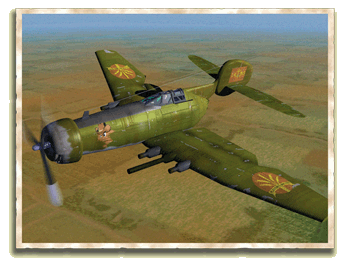
 |
|
||||||||||||||||
 |

Aircraft In Review  Featured Aircraft: Marquette PR-1 Defender
Featured Aircraft: Marquette PR-1 DefenderBy Lance "Lightning" Hawkins In my travels across North America, I often have a chance to test a plane most folks wouldn't be allowed near. While visiting the Confederate-Collective border town of Kansas City last month I was approached by Colonel Frank Rodgers, an officer of the People's Air Militia, and offered a chance to try out their PR-1 Defender, the backbone of the People's Collective air forces. This committee-designed fighter is rarely seen outside socialist nations and the pirate havens of Free Colorado, so I agreed...albeit reluctantly. The Defender has a reputation for poor design and awful handling. Many combat pilots sneer at the Defender as a product of "committee planning sessions, with complete idiots running the committee." Still, the successes of "Easter" Whittaker's "Avatars"—who fly Defenders exclusively—are undeniable. After Colonel Rodgers made some arrangements he and I crossed from Kansas City, Missouri, to Kansas City, People's Collective, where Comrade Long of the People's Diplomatic Corps joined us. Long was apparently my watchdog, and Colonel Rodgers seemed to pay a lot of attention to his opinions. The Plane Defenders are used by most of the People's Air Militias, from the local Collective squadrons to the central military forces. Primarily intended as a dogfighter, it also serves as a light rocketry platform, patrol plane, and interceptor. The typical Defender mounts four .30-caliber machine guns, and two .50-caliber machine guns, although Colonel Rodgers claimed that some field Defenders have all .30s or all .50s, usually depending on availability of parts and other maintenance concerns; it also carries four rocket hardpoints, standard. The Defender is lightly armored and reinforced; Collective pilots are encouraged during training to stay on the offense. The tactical superiority of this approach was the main topic of conversation as we flew from the Kansas City (PC) border airfield to the heavily defended 20th People's Militia Air Field in a rattletrap autogyro. I was extremely impressed with the attention to security detail; trench-works, pillboxes, anti-air gun nests, and rocket racks surrounded the airfield, and armed guards met the autogyro, Simonov rifles at the ready. The Test After a quick sandwich with the friendly—but watchful—guards, Colonel Rodgers and I got into our flight gear. Colonel Rodgers flew armed; in fact, he formally declared in front of Comrade Long and the guards that he was going armed with his TT-33, that it was his duty to safeguard the possession of the Defender, and that if I should attempt to steal the Defender it was his sacred duty to kill me to prevent the Defender from leaving the People's possession. This seemed to be accepted by everyone but me as a solemn but routine statement. My test was to barnstorm and strafe a practice range. I've never been told to "barnstorm" on a range, and I assumed the Rodgers meant I would be flying through hangars. He didn't; he meant the old style of barnstorming—fly though a good old-fashioned hay barn. Evaluation Colonel Rodgers briefed me as I neared the practice range; my run was to storm the first barn, strafe a field on the other side, fly around a pair of grain towers, and rocket the "obvious target." I could then fly for a bit before returning to the airfield. I approached the range at a slightly high angle, hoping to get a view of the field. I didn't manage to see much, as the barn was on a slope. Trusting to the impressive agility of the Defender, I shot through the hay barn, pulled up sharply as the slope rose beyond the barn, and rolled at the top of my arc for a look at the field. The Defender hung at the top of the arc most impressively for a moment before the engine started coughing like a morning smoker. I gunned the engine to keep her running and plunged on my target much faster than I had anticipated. I had hoped to linger over the field a bit and really spray the targets, but the engine's need for a steady feed didn't allow it. I did manage to shake out a decent spray of fire, based on the plane's control, but I would have been happier if I'd been able to hold her at a slower speed. I also noticed that one of the .30s hesitated in the middle of firing, although it loosened up again as I flipped back over. This task finished, I noted the twin grain towers, circled them tightly, and looked around for the "obvious target." I didn't see it, but realized the canopy didn't allow me to see in my rear quarter very well. This helps explain why the People's Air Militia's still fly three-plane formations—they need the extra eyes. Finally, after couple of partial turns, I spotted the target: a hulking old armored car. The car looked like the remains of a Davidson Razorback, with its main .70-caliber turret opened up. Having learned my lesson last time, I made a standard approach, fired one AP rocket for a clean hit, and followed through with a burst of fire. I returned to target for a second burst, and was pleased to see I had split the target wide open—the Razorback is notorious for its tough shell. I was rated at 36% for direct hits, 62% destroyed targets. The Defender's guns aren't particularly accurate, but this can be compensated for through sustained fire. The rocket payload is medium-sized, but with a proper approach and linger can be made accurate enough to pinpoint targets—but nobody should mistake the Defender for a fighter-bomber, as it lacks the armor it needs to survive a rocket run against a defended target. The tightly centered wing-mounted guns should make for an accurate firing array, and they did allow me to strafe the area, but I suspect that the firing trouble I experienced makes up for the theoretical advantage of the gun arrangement. After completing my combat test, I opened the throttle up, and took her up to her cruising speed of 360 m.p.h. The Defender is as fast as most of her opponents, and I suspect that a familiarized pilot can use her agility as an effective air brake. Overall, the agility and simplicity of the Defender is her strongest advantage. I suspect that the engine difficulties are as much to do with the grain alcohol-gasoline fuel mix I am now aware the Collective uses as any deficiency of the engine. I recommend to anyone who acquires a Defender to replace the guns with something a bit more robust, but for Heaven's sake, don't mess with the control surfaces. 
Profile:
|